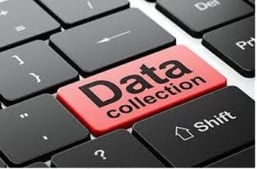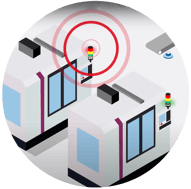The concepts behind Industry 4.0, IIoT (Industrial Internet of Things), Smart Manufacturing, and Factory of the Future generate lots of buzz, promising efficiencies that were once beyond the imagination of most manufacturers. However, many struggle to find a good entry point for getting started. As we all know, high-end technology isn't cheap, so what's the best way to get ahead of the competition while gaining the fastest ROI? Here are my top Industry 4.0 tips, technologies, and methodologies that pay off now.
Jump to a Section
|
What is Industry 4.0?
First introduced in 2006, Industry 4.0 is defined as the fourth industrial revolution. This new way of manufacturing consists of increased connectivity between machines and people, leading to improved monitoring and control, greater automation, increased production efficiency, and improved quality (among many other benefits).
![]() The IDC estimates that the worldwide market for smart manufacturing technologies will grow from $87 billion in 2017 to $158 billion in 2022. In other words, Industry 4.0 is here to stay.
The IDC estimates that the worldwide market for smart manufacturing technologies will grow from $87 billion in 2017 to $158 billion in 2022. In other words, Industry 4.0 is here to stay.
As an increasing amount of industrial automation components have become IIoT-friendly, a significant return on investment can be realized today for a minimal investment in Industry 4.0 technology.
Overall Benefits of Industry 4.0 Technologies
Companies implementing Industry 4.0 technologies sooner will have a distinct competitive advantage over their competition by seeing the following:
• Improved efficiency: IoT-enabled systems allow manufacturers to monitor and optimize production and processes in real-time, resulting in reduced waste, less downtime, and better product quality.
• Increased productivity: By providing streamlined access to production data and analytics, IIoT technologies enable teams to make more informed decisions and take proactive measures to improve efficiency and reduce costs.
• Decreasing unplanned downtime: Real-time monitoring allows manufacturers to identify potential issues and address them before they cause costly downtime or injuries.
• Improved customer satisfaction: By automating processes and making data available on demand, IIoT technologies make it easier for suppliers to deliver high-quality products on schedule and respond to customer needs quickly.
-
Tip 1: Make the Move to Predictive Maintenance (PdM)
Why switch to a predictive maintenance model?
All components degrade over time to the point where they will need to be repaired or replaced - there's no way around it. One could wait until a part reaches its end of life before replacing it—run it until it breaks—but this reactive maintenance approach results in unplanned downtime, is inefficient, and is not cost-effective in the long run.
Preventive maintenance programs, which are time-based, may seem like the right approach since parts and equipment are maintained or replaced regularly. Still, this schedule is usually based on worse-case predictions regarding a component's lifetime. It doesn't consider the equipment's age or actual usage. As a result, parts are often replaced before they have reached their end-of-life state. Unplanned downtime for maintenance is reduced, but overall downtime may increase due to the performance of maintenance that may be unnecessary. And catastrophic equipment failures are still a possibility since the actual condition of the system is not being monitored.
 PdM, on the other hand, provides the correct information to the right people at the right time. It empowers workers to fix equipment issues before they become more serious. Predictive maintenance programs are based on the equipment's actual condition, not a set maintenance schedule. Equipment degradation is measured using sensor data indicating conditions such as temperature, humidity, pressure, noise, vibration, and other predictors of upcoming failure.
PdM, on the other hand, provides the correct information to the right people at the right time. It empowers workers to fix equipment issues before they become more serious. Predictive maintenance programs are based on the equipment's actual condition, not a set maintenance schedule. Equipment degradation is measured using sensor data indicating conditions such as temperature, humidity, pressure, noise, vibration, and other predictors of upcoming failure.
Presence sensors and controls, as well as data storage and processing via cloud technologies, allow manufacturers of all sizes to tap into the promise of predictive maintenance. This data is connected to cloud-based programs and becomes "smart data" when analyzed against other datasets, which might include:
• Equipment stats, like, model and configuration
• Existing engineering data, like expected performance models based on manufacturers' testing data, End-of-Life (EoL) information, or other historical data
• Usage data, like the number of starts, cycle times, or load statistics
• Maintenance data, like service frequency or part replacement history
• Determine if the equipment is likely to fail within a specific timeframe or predict its remaining life
 Smart data can also trigger alerts indicating unusual equipment behavior. Mobile devices can receive these alerts on a 24/7 basis, and system settings can be adjusted and optimized remotely to maximize performance instantly.
Smart data can also trigger alerts indicating unusual equipment behavior. Mobile devices can receive these alerts on a 24/7 basis, and system settings can be adjusted and optimized remotely to maximize performance instantly.
Another plus for OEMs and integrators—remote monitoring can open up a new revenue stream from Maintenance-as-a-Service (MaaS) programs they can provide for their customers!
How Predictive Maintenance Pays Off Now
Upgrading existing machines and production platforms to implement an Industry 4.0 predictive maintenance program can pay off significantly, especially in large facilities with thousands of maintenance points.
Based on our experience in successfully implementing maintenance programs, the average total return on investment for a PdM program is at least 30% per year, including savings of up to 25% on maintenance costs and 5% on inventory costs.
These savings come in addition to intangible benefits such as improved customer satisfaction, reduced downtime, and lost production due to equipment failures.
This modernization does not need to happen overnight, affordable incremental upgrades can be made over time. Thus, upgrades can be made during scheduled maintenance or periodic inspection (for example, small sensors can be mounted on equipment). Adding additional sensors over time means more data points will be monitored, increasing the overall digital intelligence of the system.
Connecting this sensor data to the cloud can now be achieved without additional engineering or programming costs using configurable solutions such as Phoenix Contact's PLCNext or Bosch Rexroth's ctrlX. These gateways make it easy to connect sensors and smart devices to your IT infrastructure and capture and analyze data from them for machine-learning purposes.
|
Predictive Maintenance Solutions by Omron
|
Tip 2: Use IIoT Data to Improve Quality and Production
Why Use IIoT Data?
 Companies can't afford to ignore their data or skimp regarding quality in today's competitive environment. While cost pressures remain a concern, you can significantly improve your manufacturing processes by using smart data to increase quality and output and reduce waste. Industry 4.0 technologies aggregate cloud metadata with sensor data relating to raw materials, the working environment, output, waste, and other metrics. This real-time smart data can trigger alarms to notify quality-control personnel, machine operators, and plant managers, who can immediately correct quality issues. If an issue is severe enough, it can also automatically shut down the process or machine to prevent damage and further issues.
Companies can't afford to ignore their data or skimp regarding quality in today's competitive environment. While cost pressures remain a concern, you can significantly improve your manufacturing processes by using smart data to increase quality and output and reduce waste. Industry 4.0 technologies aggregate cloud metadata with sensor data relating to raw materials, the working environment, output, waste, and other metrics. This real-time smart data can trigger alarms to notify quality-control personnel, machine operators, and plant managers, who can immediately correct quality issues. If an issue is severe enough, it can also automatically shut down the process or machine to prevent damage and further issues.
Error-Proof Your System
A manufacturing plant with smart, connected equipment can also continually analyze data to improve process efficiency.
![]() A core tenet of continuous improvement is reducing all forms of waste, and IIoT data can be evaluated to increase throughput and cut down on scrap and rework. Error-proofing methods can be enhanced and monitored production processes can be adapted to become leaner.
A core tenet of continuous improvement is reducing all forms of waste, and IIoT data can be evaluated to increase throughput and cut down on scrap and rework. Error-proofing methods can be enhanced and monitored production processes can be adapted to become leaner.
Since most quality problems stem from human error, it makes sense to implement Industry 4.0 technologies to lessen operator errors by eliminating non-value-added steps or reducing the number of decisions operators need to make. Production data is accurately recorded and can be accessed via unique serial numbers for full traceability, making quality consistently high.
|
GET A RISK-FREE TEST KITSmartMONITOR by WERMAThe easy way to collect vital data and keep track of your entire operation, whether you use machines, systems, or even manual workstations.
|
In addition to connected manufacturing equipment, companies are also producing connected products, which add usage metrics to the mix of data available to quality management personnel. By embedding smart sensors into the products they sell, manufacturers are gaining new insights regarding product performance, "where the rubber meets the road," and can implement ways to improve reliability and overall customer satisfaction. This emerging technology promises to be a game-changer, uncovering new opportunities for product improvement or development.
How IIoT Data Pays Off Now
The benefits of intelligent manufacturing extend far beyond improving quality. Besides increasing efficiency and product quality, accurate data improves financial forecasting and helps you make better business decisions. It can also mitigate risk by providing an accurate picture of your facility's performance at all times so that you can quickly identify and address any issues before they escalate and cause costly downtime. Precise production data gives you greater insight into the performance of your machines, enabling you to manage your resources better and improve production capacity.

Need help implementing Industry 4.0 technology? We're here to help!
|
In summary...
What kinds of benefits can you expect from implementing an IIoT strategy? First and foremost, it will help address your most critical business challenges and make strategic decisions, positively impacting your bottom line. In addition, it will enable you to improve product quality and productivity and better manage your resources. It also helps you stay ahead of the competition by responding more quickly to changing market conditions, providing valuable insights into your business to make better decisions, and driving business growth and innovation.
Need more help?
More Articles & Resources
More Automation Technically Speaking Articles
Maintenance Strategies Explained
5 Common Presence Sensors for Industrial Automation
Airline's Maintenance Solutions
Omron's Predictive Maintenance Brochure
Lean Manufacturing 101: Explaining Ergonomics, 5S, and Lean Principles

















Leave Comment